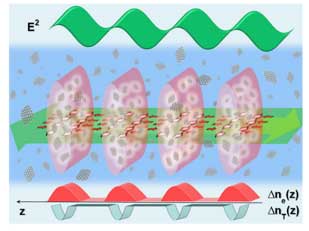| Jan 28, 2019 | |
Scientists investigate graphene's effect on light-wave interaction(Nanowerk News) Two-dimensional (2D) nanomaterials (graphene, black phosphorus, transition atom chalcogenides, etc.) are helping facilitate nanostructure science. Their outstanding nonlinear optical properties like enhanced two-photon absorption and absorption saturation make new application possible in laser technologies, optical computing and telecommunications. |
|
| Nowadays, ongoing wave mixing studies in 2D materials mainly focus on harmonic generation. Four-wave mixing in near infrared was recently carried on a graphene monolayer, and revealed a third-order nonlinear susceptibility χ(3) value, which is about 7 orders of magnitude larger than in bulk insulators like silica and BK7 glass, 3-5 orders larger than in bulk semiconductors like silicon, germanium, cadmium and zinc chalcogenides, metal oxides, and 10 times larger than in thin plasmonic gold films and nanoparticles. | |
| Most recently, an even larger value was obtained in graphene nanoribbons at mid-infrared frequencies close to the transverse plasmon resonance. | |
| Despite these not yet abundant but impressive advances of phase conjugation in graphene, the effect of 2D materials on Stimulated Brillouin scattering (SBS) remains overlooked. Due to its fundamental importance in laser and fiber telecommunications, the effect currently attracts theoretical considerations concerning bulk and composite semiconductor materials, including practical designs. | |
| Recently, a collaborative study led by Prof. Dr. WANG Jun at Laboratory of Micro-Nano Optoelectronic Materials and Devices, Key Laboratory of Materials for High-Power Laser, Shanghai Institute of Optics and Fine Mechanics, Chinese Academy of Sciences, investigated the character of SBS of low-concentration graphene nanoparticle suspensions in N-methyl-2-pyrrolidone (NMP) and water (Optics Express, "Stimulated Brillouin scattering in dispersed graphene "). | |
| They found a strong SBS quenching effect which was attributed to the interference of density gratings formed in the liquid by electrostriction and thermal expansion forces (see Fig. 1). | |
 |
|
| Fig. 1. Sketch of the electrostriction – thermal expansion antagonism (Image by SIOM) | |
| Established linear dependences of SBS threshold on graphene absorption coefficient (i.e., concentration) can be used for the detection of small nanomaterial quantities in liquid media down to 5×10-8g·cm-3. | |
| Computer simulations of the Brillouin gain factor show the efficiency of different thermodynamic, electrooptic and photoacoustic parameters in the SBS quenching. The role of density and compressibility, which change as a result of carbon vapor bubble formation, is found to be decisive in leading to dramatic changes of refractive index, electrostrictive and acoustic damping coefficients. | |
| The effect can give tools to bubble nanosecond dynamics studies and a method of SBS suppression in optical composites applicable in laser technologies and optical telecommunication networks. |
| Source: CAS | |
|
Subscribe to a free copy of one of our daily Nanowerk Newsletter Email Digests with a compilation of all of the day's news. |
